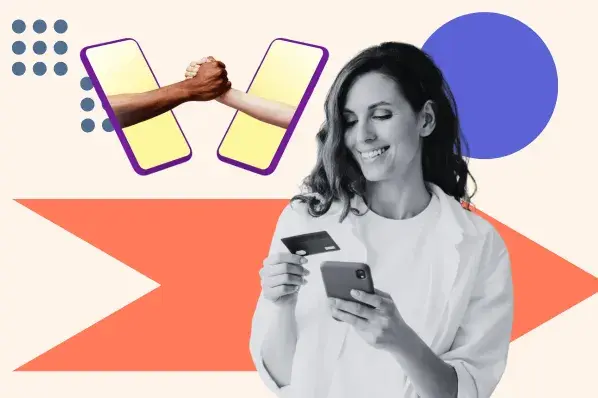Loyal customers, while they're a small group, make a big impact on your business. Loyal shoppers spend more money on your products and are more likely to return for future purchases.

While most companies understand this value of customer loyalty many have trouble finding and retaining loyal customers. Customer loyalty is an evolving field that has new trends arising each year which impacts customers' needs. If businesses expect to meet these needs, then it's important for them to monitor industry trends and statistics for changes that may influence customer loyalty.
If your company is looking to stay on top of the latest customer loyalty data, we put together a list of stats that you'll want to consider in the coming year.
Jump to:
Customer Loyalty Statistics
Marketing and customer service professionals analyze customer loyalty statistics to understand the needs of their most valuable customers. These metrics indicate popular trends in consumer behavior that influence specific customer needs. By monitoring customer loyalty statistics, businesses can adapt their product offers to find and retain loyal shoppers.
“Customer expectations and experiences continue to be key determinants of brand and company loyalty, with consistent preferences for self-service, personalization, and real-time resolutions,” says Poorvi Shrivastav GM, HubSpot Service Hub.
Here are some statistics on customer experience, loyalty, and programs that we have on our radar.
1. Customer satisfaction (CSAT) remains the most important KPI.
According to HubSpot research, CSAT remains the most important KPI for 75% of customer service leaders. However, almost 50% are now also responsible for customer experience and ensuring customer success, which is an increase of more than 10% from last year
2. Customer expectations continue to increase.
HubSpot's report found 2021 was a hard year for service teams, with almost 90% of leaders reporting that customer expectations have increased to an all-time high.

Additionally, the report found that customers are more informed than before and more likely to share both negative and positive experiences than before. Social media has made it easier to share reviews, so it's imperative that service teams work to meet or exceed customer expectations to avoid being shown in a bad light online.
3. The top 10% of your customer base is spending 3x more than your average customer.
As we mentioned earlier, loyal customers will spend more money at your company than any other person walking into your stores. In fact, Adobe found that the top 10% of your customer base is spending three times more than your average customer — and your top 1% is spending up to five times more. This is why it's important for businesses to pursue customers who are more likely to become loyal, rather than just marketing to anyone.
Using tools like buyer personas and a CRM is one way for companies to highlight potential leads who are more likely to become loyal customers.
4. 51% of service teams cite proactive customer service as a top priority to improve retention.
Successful service teams know that happy customers become repeat customers. Service leaders also realize that their work is fundamentally tied to the customers’ ongoing relationship and satisfaction with the company.
5. Acquiring new customers is 5 times more expensive than existing customers.
According to HubSpot’s State of Service Report, retaining customers was cited as one of the top three priorities. This prioritization suggests a pivot from viewing customer retention as an expense, to now as a revenue-generating activity.
6. 67% of customer churn is preventable if the issue is resolved during the first interaction.
If you're looking for a stat that proves the worth of your customer service team, this would be the one to mention in the next staff meeting: According to thinkJar Research, 67% of customer churn is preventable if the issue is resolved during the first interaction. This means that a good customer service team can be the difference between you losing and keeping a loyal customer.
It's essential to invest in your customer service teams by providing them with the right tools that help handle customer interactions. Doing so can lead to an improvement in customer experience as well as customer loyalty.
7. Customers with an emotional connection to a brand have a customer lifetime value that's 4x higher than the average customer.
In a study of over 100k consumers, Motista found that customers who are emotionally connected with a brand have a lifetime value that's 306% higher than the average customer. Customer lifetime value is a key consumer metric because it tells companies how much revenue they can expect one customer to generate over the course of the business relationship. If your brand can create memorable and positive interactions, customers will be much more likely to buy from your company again, thus increasing lifetime value.
8. 90% of customers rate an “immediate” response as important or very important when they have a customer service question.
Your business will make mistakes, and while it's important to learn from them you also need to keep in mind that these mishaps aren't inconsequential. HubSpot found that 90% of customers rate an “immediate” response as important or very important when they have a customer service question and 60% of customers define “immediate” as 10 minutes or less.
A previous study by Accenture found that 47% of consumers stop doing business with a brand after the company disappoints them. Your business may not be perfect, and you will fall short at times, but it's important to remain dedicated to customers' needs — especially when you fail to fulfill them the first time around. If you don't, customers will likely look to your competitors who can meet their expectations.
One aspect of customer loyalty that has grown in popularity over the years is the use of loyalty programs. Customers can sign up for these loyalty programs to obtain continuous benefits from the company over time. As researchers continue to look into the different elements of customer loyalty, many interesting statistics have surfaced regarding these memberships.
Loyalty Program Statistics
Loyalty programs are an effective way for businesses to optimize the value of their most loyal customers. If your company doesn't have a loyalty program or is looking to improve your existing one, take a look at these statistics which explain how using these programs can make your exclusive offers a bit more enticing.
1. The customer loyalty management market is valued at 5.5 billion dollars.
According to Statista, the entire customer loyalty management market worldwide is valued at more than 5.5 billion U.S. dollars and it is expected to surpass 24 billion by the end of 2028.
2. Loyalty program participants love cash back.
According to Statista, 49% of consumers were using the cashback feature of their brand loyalty program to redeem when making purchases with the brand while 32% of businesses were using exclusive membership perks as part of their strategy.
3. 74% of customers subscribe to free loyalty programs.
Free customer loyalty programs were by far the most popular with 74% participation according to Statista. Offering a program free of charge creates a risk-free way for consumers to connect with and support your brand.
Still, some customers looking for more value may be willing to pay more to get it. In fact, a Bond report found 37% of customers are willing to pay more money to upgrade to an enhanced tier of a customer loyalty program. This presents an opportunity for brands to make more from customers who are looking to further engage with the company.
Instead of adding more options to one program and hiking up its price, brands can create different levels to their loyalty memberships that have varying benefits depending on what customers choose.
For example, you could create a program with a gold, silver, and bronze status. Bronze would have basic features, silver would have a little more, and gold would have the most. This way your business can continue to derive more revenue from customers who have already maxed out on their current loyalty plan.
4. U.S. consumers belonged to 16.6 loyalty programs on average.
According to Statista, in 2022 US 2022, U.S. consumers belonged to 16.6 loyalty programs on average but actively used a little less than half of those.
Don't have a loyalty program, yet? Well, it may be time to start drawing up plans for it because previous research shows that more than half of your loyal customers will join your loyalty program if you offer them one. Even if you just offer them discounts and sales, the reduced prices and increased customer satisfaction will only lead to more visits from these customers. Plus, they'll feel more incentivized to shop with your company because they're actively invested in your loyalty program. Loyal customers contribute some of the highest revenue to your business, so why not give them a chance to spend more?
5. 75% of consumers would engage more with loyalty programs that make rewards mobile-friendly.
Many companies will allow customers to claim loyalty rewards through their website. However, these rewards are often hard to redeem because the application they're displayed on isn't mobile-friendly. That means that when customers try to scan the discount in the store, the scanner can't read the code because it's skewed by the mobile screen. This can lead to customer frustration and negative customer experiences.
Businesses have been able to counteract this roadblock by offering their rewards through a mobile app. Consumers engage more with loyalty programs that offer mobile-friendly rewards. Companies like Starbucks use their app to push out promos and discounts that loyal customers can download, and since the app is designed for mobile use, these discounts render properly on the mobile screen and are easily scanned.
Additionally, Statista reports that 12% of customers participated in loyalty programs that allowed for mobile-friendly payment.
6. 70% of consumers would be more likely to recommend a brand with a good loyalty program.
One intangible effect of loyalty programs is that it gives customers the feeling of being part of a community or group. This is because the people who belong to these programs have access to premium offers and information that other people don't. Luckily, customers aren't very humble and are likely to brag about their exclusive status to other customers who are shopping in the same marketplace. In fact, 70% of consumers are more likely to recommend a brand if it has a good loyalty program.
Think about brands like Amazon, who have created popular loyalty programs for their customers. Almost every Amazon Prime member loves to boast their free two-day shipping status whenever they place a new order. That excited feeling about getting a good deal is what makes customers share their experience with other consumers who are looking to achieve the same result.
For information about building and managing customer loyalty, read about customer loyalty analytics.
Integrate A Customer Loyalty Program Into Your Business
Adopting a customer loyalty program is a great way for your business to identify and retain loyal customers and investing in it over time can lead to increased customer referrals, positive customer reviews, and improved customer satisfaction.






![How & Why Loyalty Punch Cards Attract Customers to Your Brand [+ Examples]](https://www.hubspot.com/hubfs/customer-loyalty-punch-card_6.webp)




